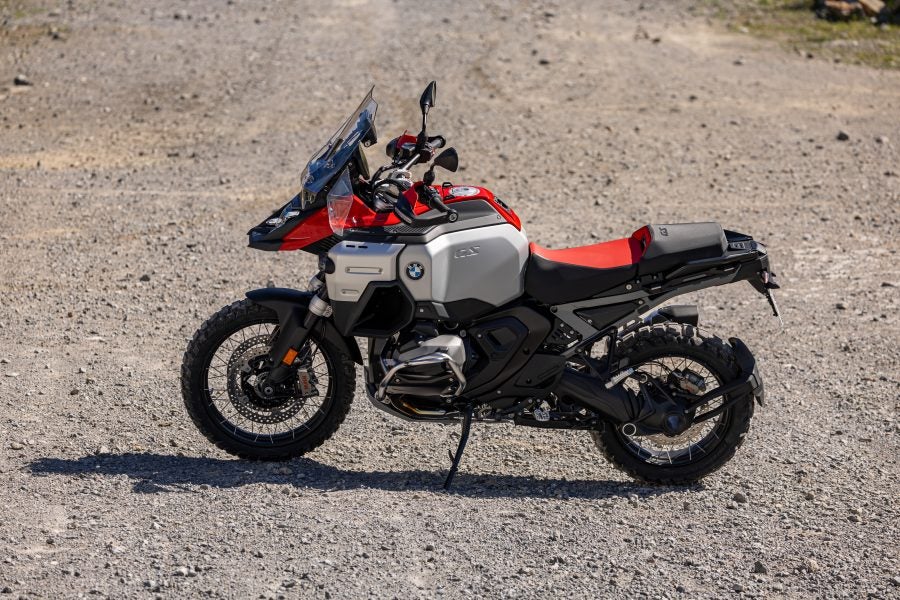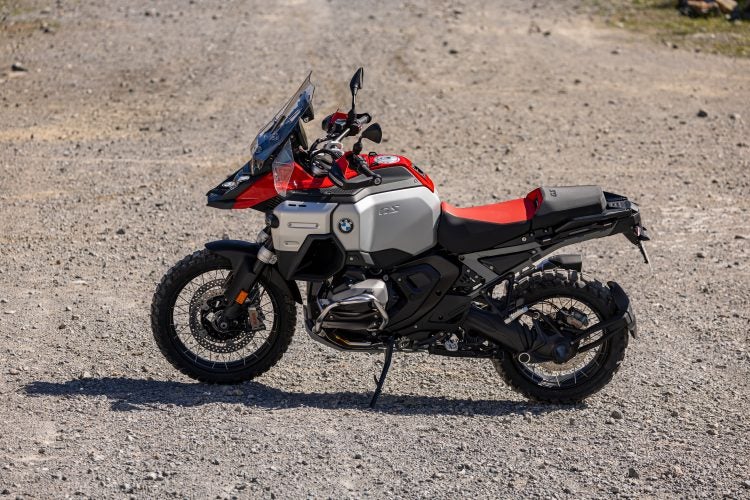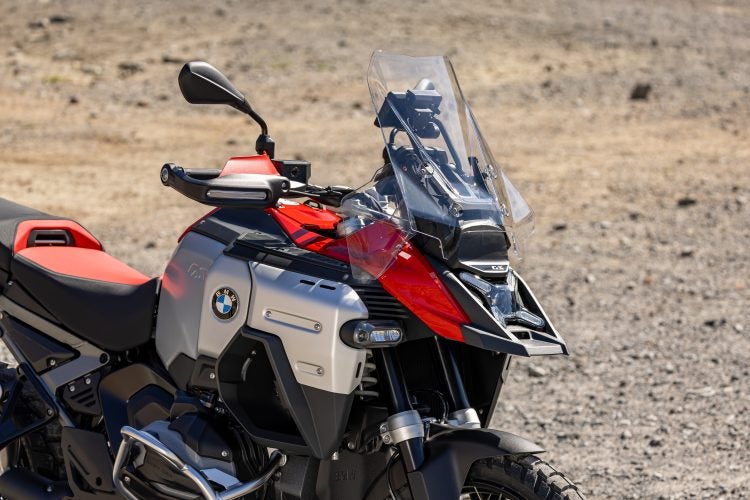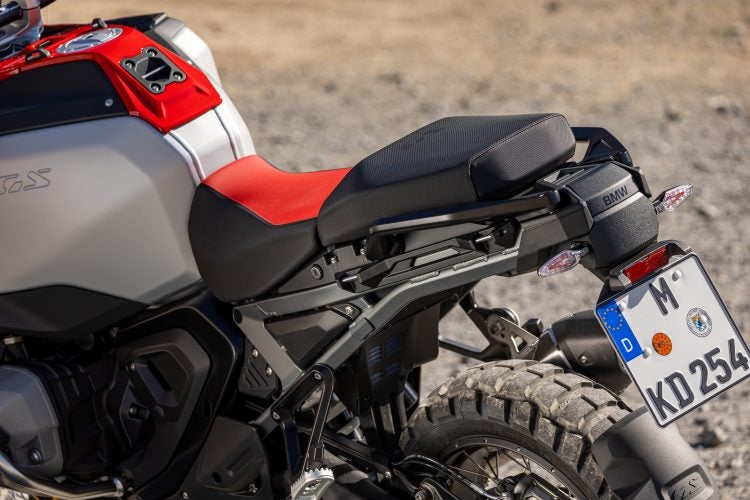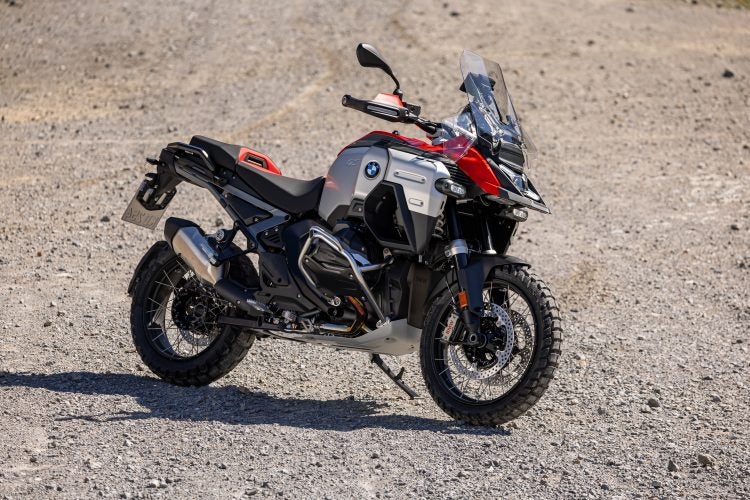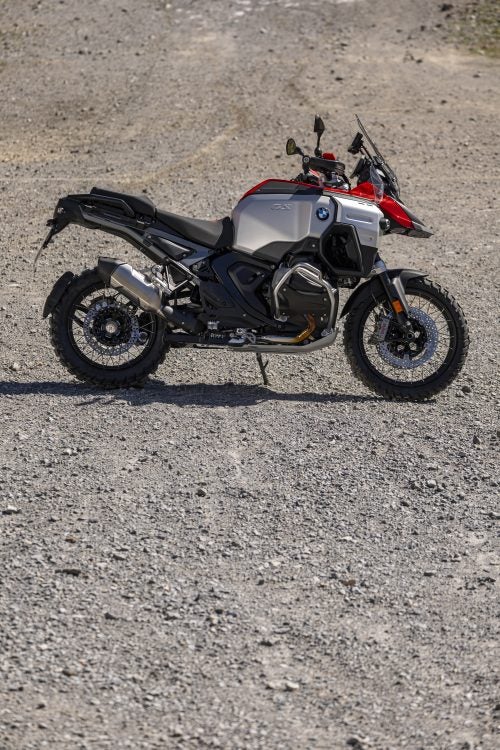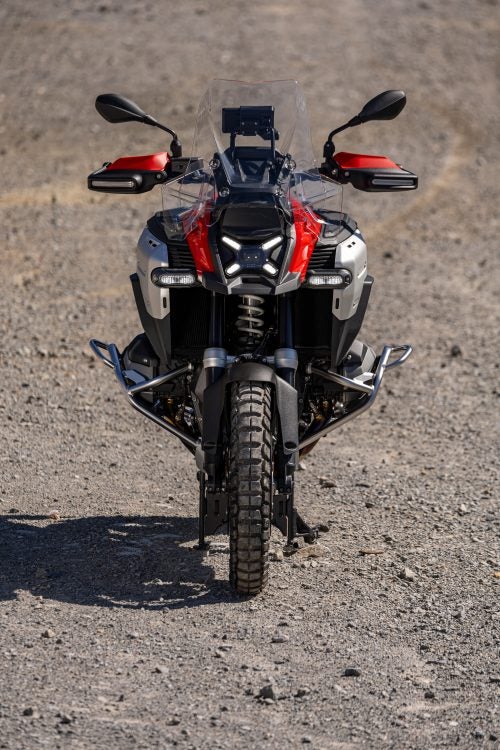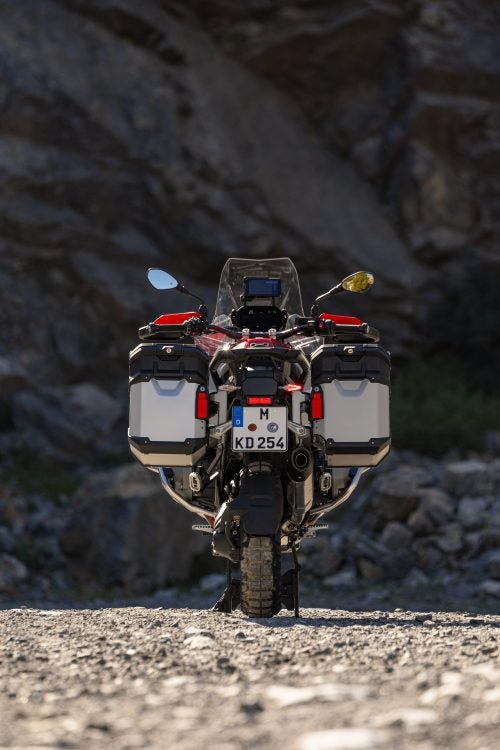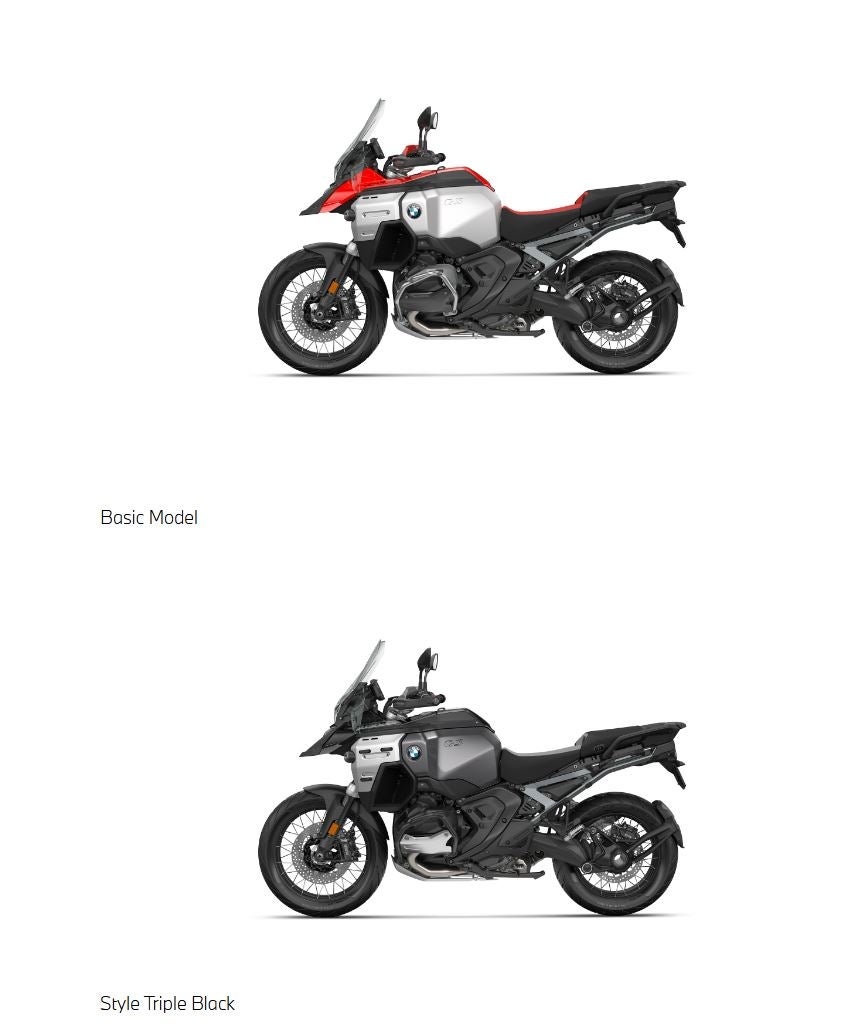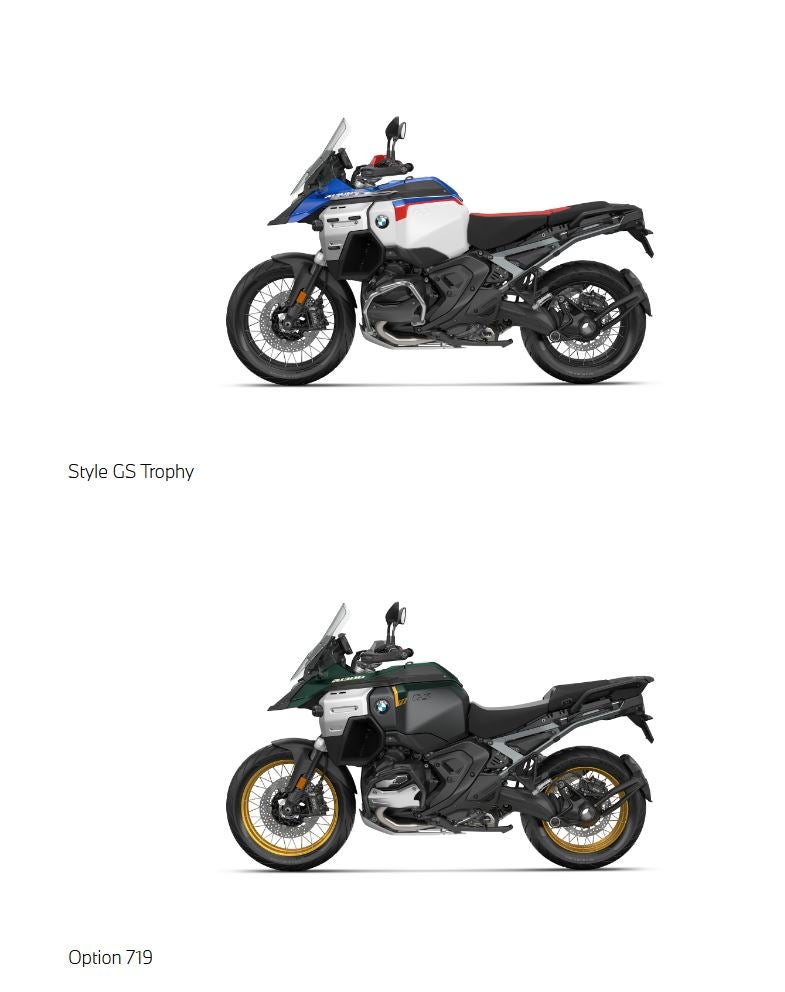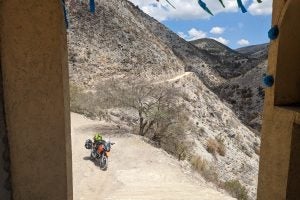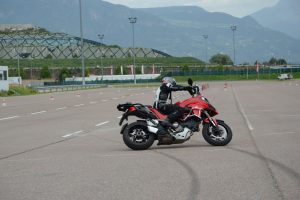The wraps are off one of BMW’s most well-known and popular adventure motorcycles. The new 2025 BMW R 1300 GS Adventure has been revealed ahead of its 2024 Q4 market release. For this newest generation of big GS machines, BMW has made big (in reality, massive) changes to its largest displacement adventure machine.
The list of changes, upgrades, and capabilities is very long, so the TLDNR is that the new 2025 BMW R 1300 GS Adventure includes:
- New engine
- Completely redesigned chassis
- Optional Automated Shift Assistant (no clutch lever)
- Upgraded electronic systems:
- Optional Electronic Dynamic Suspension Adjustment (DSA) with dynamic adjustment of the damping and spring rate as well as load compensation.
- Optional Adaptive Vehicle Height Control or Adaptive Vehicle Height Control Comfort.
- Standard Matrix LED headlights and newly developed auxiliary lights integrated into the body.
- Optional Headlight Pro with adaptive headlight.
- Standard Dynamic Cruise Control (DCC) with brake function.
- Optional Riding Assistant with Active Cruise Control (ACC), Front Collision Warning (FCW), and Lane Change Warning for safer and more convenient motorcycling.

The many generations of the venerable GS. Image: BMW Motorrad
That’s the brief list of changes, but the reality is that there are many other changes/upgrades and we will get into them in more detail below.
Engine and Drivetrain
Cradled in the R 1300 GS Adventure’s new frame is a completely redesigned boxer engine. The new powerplant now displaces 1,300 cc (106.5 mm bore and 73 mm stroke). The result is an engine that now produces a claimed 145 hp at 7,750 rpm with a max torque of 110 lb-ft at 6,250 rpm. With its 9,000 rpm redline, the new engine is BMW’s most potent Boxer engine to date. BMW also claims that the new 1,300 cc engine offers more torque across the entire rpm range, especially between 3,600 and 7,800 rpm.
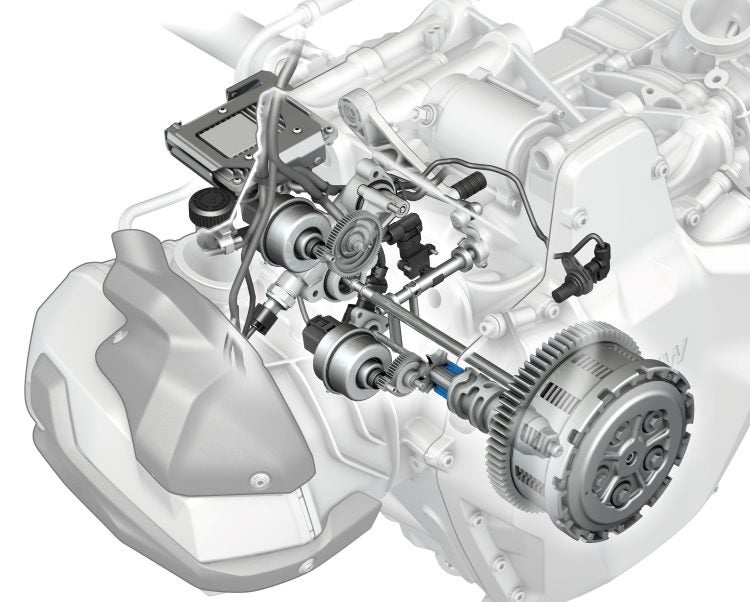
The BWM’s R 1300 GS Adventure’s engine has been heavily revised. Image: BMW Motorrad
BMW’s ShiftCam technology is retained with a partial load cam that optimizes fuel economy and smooth running, while a full load cam is designed to optimize the engine’s performance. According to BMW:
“The intake cams for the left and right-hand intake valves of the partial-load cam differ in stroke and angular position. This phase shift causes the two inlet valves to open with a time delay and to different extents. The effect of this phase shift manifests itself in a swirl and thus a stronger turbulence of the fuel-air mixture flowing into the combustion chamber. As a result, the new BMW R 1300 GS Adventure benefits from more effective combustion.”
New Transmission
The R 1300 GS Adventure’s six-speed transmission and clutch are integrated into the engine housing. This means that the transmission is no longer located behind the engine but underneath it. BMW claims the new arrangement reduces overall length and improves weight balance since the transmission shafts are now significantly shorter. The new configuration reduces the engine’s basic weight by 8.6 pounds. In addition, a greater concentration of mass moves towards the bike’s overall center of gravity to improve handling.
Shaft Drive And Axle Hub
The R 1300 GS Adventure’s new driveline changes extend to its shaft drive and rear axle hub. The shaft drive now has larger universal joints, and its reduced deflection angle reduces “…the non-uniformity of the rotational transmission that is inherent in propeller shaft joints.” In addition, the rear axle hub’s new design now has a longer rear axle stub for easier mounting and dismounting of the bike’s rear wheel.
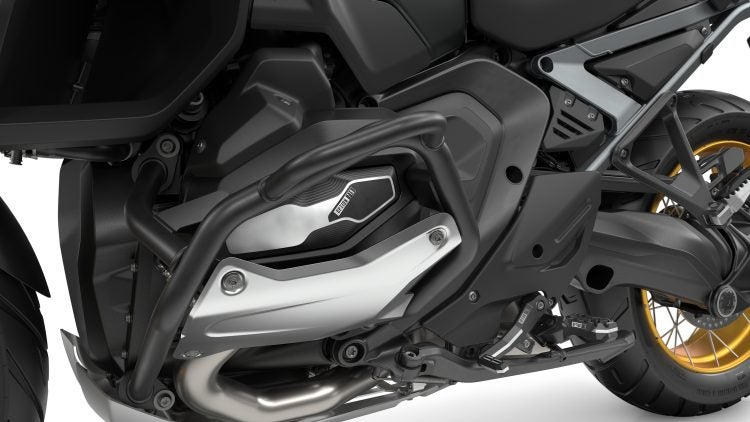
The shaft drive now has larger universal joints with a reduced deflection angle. BMW Motorrad
Chassis and Suspension
With a new engine, BMW decided it was time to design a completely new suspension. The chassis now has a new steel sheet metal main frame, which offers more compact packaging and higher stiffness than the frame it replaces.
In addition, the rear frame features a completely new design. A new aluminum lattice tube frame replaces the previous steel tube construction. BMW’s choice of the load-bearing, hexagonal extruded aluminum tubes for the lower beam is based on its belief that the new R 1300 GS Adventure will be used primarily for long journeys.

For 2025, the BMW R 1300 GS Adventure gets an all-new chassis. Photo: BMW Motorrad
In that regard, seating comfort for the rider and passenger and a high-volume luggage system have been given “top priority.” Accordingly, a two-stage seat height adjustment for the rider’s seat and a longer, more comfortable seat for the rider and passenger are linked to the concept of the rear frame.
Paralever and Telelever Updates
Both ends of the R 1300 GS Adventure receive changes that BMW says combine the strengths of two previously used Telelver suspensions. Up front, the new Telelever Evo upper fork construction uses a handlebar decoupling system that prevents any detrimental tilting movement and only transmits steering forces. Ultimately, the new setup is said to “…create significantly greater rigidity, which is reflected in the noticeable increased ride stability of the new R 1300 GS Adventure.
At the rear of the bike, the rear wheel guide has been redesigned. The new Paralever has a significantly stiffer connection via the suspension in the frame. Additionally, the swingarm bearing is now arranged off-axis of the rotation of the shaft drive joint.
As a result of these changes, the R 1300 GS Adventure receives 0.8 inches more suspension travel at both the front and the rear of the machine, with spring travel now 8.3 inches at the front and 8.7 inches at the rear.
Dynamic Suspension Adjustment (DSA)
BMW says its standard latest iteration of DSA combines the dynamic adjustment of the front and rear damping with a corresponding adjustment of the spring rate (“spring stiffness”) in concert with the selected riding mode, riding condition, and maneuvers. According to BMW, the system’s automatic adjustment of the spring preload ensures appropriate load compensation.
Optional Adaptive Vehicle Height Control (AVHC) and Adaptive Vehicle Height Control Comfort (AVHCC)
The R 1300 GS Adventure has two standard adjustable seat heights of 34.3 inches and 35.0 inches. However, BMW’s optional AVHC offers fully automatic vehicle height adjustment depending on conditions. When stopped, the bike’s standard adjustable seat height is reduced by 1.2 inches to 33.1 inches / 33.8 inches. Once the bike is underway, the seat height automatically rises to 34.3 inches / 35 inches in approximately 3 seconds. Lowering takes only approximately 1.5 seconds.
For even more adjustability, the AVHCC offers an additional 0.8-inch reduction in seat height, resulting in a seat height of 32.3 inches when stopped and 33.5 inches when moving. BMW says smaller/shorter riders will benefit from these systems which can be further customized with optional extras such as a low adjustable comfort seat and comfort handlebars.
Braking
The 2025 R 1300 GS Adventure gets two new radially mounted four-piston calipers with twin discs at the front and a single disc with two-piston floating calipers at the rear. All are coupled to BMW’s Full Integral ABS Pro. With this setup, the handbrake lever activates the front and rear brakes simultaneously, and the foot brake lever also actuates the front and rear brakes simultaneously. BMW claims the Full Integral ABS Pro system is optimized for on-road and off-road use, depending on the riding mode selected. However, in ABS Pro settings, the rider can still lock the rear wheel via the foot brake lever.

Up front, the 2025 BMW R 1300 GS Adventure gets a new four-piston caliper and dual discs. The rear caliper and disc have also been redesigned. Photo: BMW Motorrad
BMW’s Dynamic Brake Control (DBC) system backs up the Full ABS Pro system. According to BMW, when in “difficult situations,” the system prevents unintentional throttle application. Using the bike’s engine control, dive torque is reduced during braking, allowing the full use of the bike’s rear wheel braking power.
Wheelsets
Two different wheelsets are available for the R 1300 GS Adventure: a 3.0 x 19″ at the front and a 4.5 x 17″ at the rear. All model variants feature standard newly developed cross-spoke wheels with aluminum rims for dedicated off-road use. As an option, BMW offers forged wheels that are also intended for off-road use and provide the benefit of a 4-pound weight reduction.
Ride Modes
The R 1300 GS Adventure arrives with an additional standard ride mode and now has four modes compared to the previous model’s three. BMW says the “Rain” and “Road” modes allow riding characteristics for most road conditions. The machine’s “Enduro” mode is said to enable “…an enhanced riding experience off the beaten track with a specific setup for off-road use.”
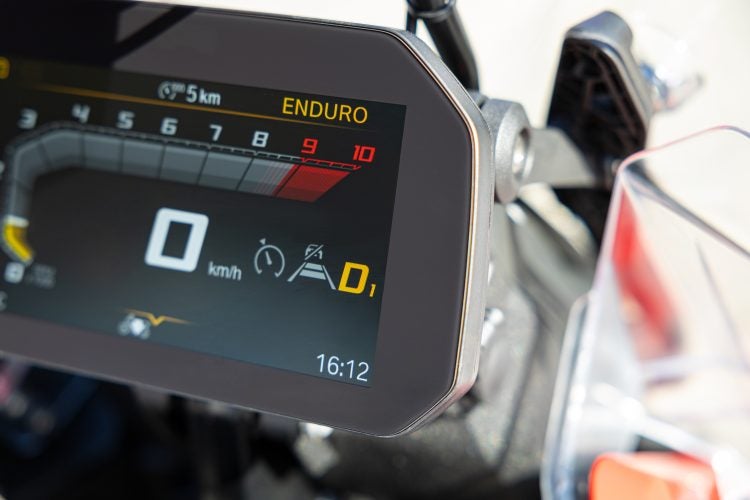
The 6.5-inch full color TFT screen is adjustable to display lots of data. Photo: BMW Motorrad
The fourth riding mode, “Eco,” uses the engine’s ShiftCam technology to “…obtain maximum range from each tank of fuel.” In Eco mode, the rider experiences a gentler throttle curve and a moderate torque limitation to provide a riding style geared toward more efficient fuel consumption. In Eco mode, an efficiency indicator is displayed on the top line of the bike’s TFT display, giving the rider feedback on the machine’s fuel economy. If maximum performance is required, BMW says that the rider can quickly switch to another rider mode by using the ride mode button.
Fuel Capacity
The 2025 R 1300 GS Adventure’s fuel tank is made of aluminum. It holds 7.9 gallons of fuel, which should provide more than adequate range for longer trips.
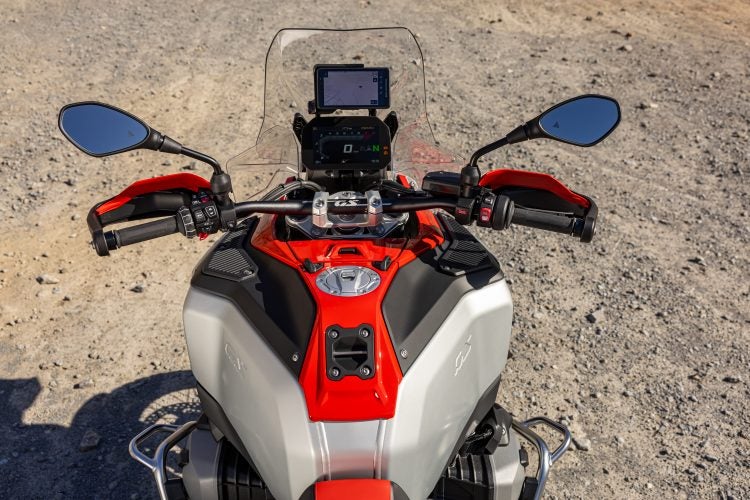
With a fuel capacity of 7.9 gallons from its welded aluminum fuel tank, range should not be an issue. Photo: BMW Motorrad
Other Electronic Assistance
Optional Riding Modes Pro
- The Optional Riding Modes Pro package adds three more ride modes, including Dynamic, Dynamic Pro, and Enduro Pro. In addition, the Dynamic Pro and Enduro Pro ride modes let the rider change the bike’s settings to their individual needs and preferences. The packages let the rider create ride a performance-oriented configuration like Dynamic and Dynamic Pro for paved roads and specialized off-road oriented settings for the bike’s Enduro and Enduro Pro modes.
Engine Drag Torque Control
- The standard Engine Drag Torque Control helps to avoid unstable riding conditions caused by coasting and downshifting. If the rear wheel encounters excessive engine braking, the system opens the throttle valves to equalize “drag torque,” stabilizing the motorcycle. How the system behaves depends on the ride mode selected by the rider. In Eco, Rain, and Road modes, the Engine Drag Control provides maximum ride stability. However, in Dynamic and Dynamic Pro modes, the control system allows slightly more slip. While in Enduro mode, the engine’s “drag torque” is only minimally reduced.
Optional Automated Shift Assistant (ASA)
You know that lever on the left side of the handlebar? It’s gone. Yep, when equipped with the new Automated Shift Assistant, the left handlebar’s clutch lever has been removed “…to make motorcycling easier and more comfortable.” According to BMW:
True to the motto “Simplify your ride”, the riding experience is enhanced by the automation of the clutch and gear shift, without sacrificing the emotionally important dynamics of the gear change.
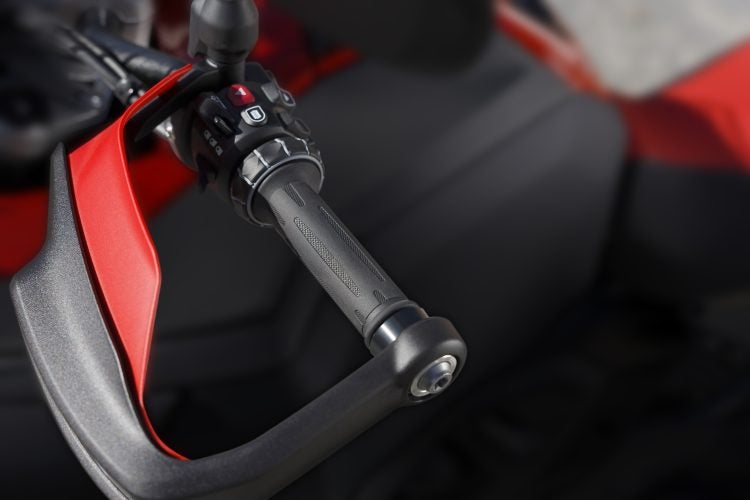
Bye, bye clutch lever. Photo: BMW Motorrad
The ASA uses two mechanical actuators to automate the clutch and gear shifting of the bike’s six-speed transmission. There’s no need for a hand lever to operate the clutch manually. Using the bike’s D shift mode, the bike’s engine control unit automatically selects shift points. In Manual “M” shift mode, riders can decide when to make gear changes using the bike’s traditional gear shift lever.

With the clutch lever removed, riders can select both manual mode (M) and automatic (D) modes with a push of a button at the base of the left handlebar. Photo: BMW Motorrad
According to BMW, in both D and M modes, the rider receives “…perfectly executed gear changes with a smooth interruption of traction.” Downshifts are delivered as smoothly as possible to minimize disturbance to the chassis. Additionally, the specific characteristics of the automated shift function are assigned to each ride mode to ensure appropriate shift behavior in each riding situation.
Benefits of ASA
BMW says the benefits of ASA are substantial and include:
- Complete elimination of clutch operation by the rider.
- Dynamic and comfortable gear changes for more riding enjoyment.
- Choice of manual or automatic shift selection.
- Automatic adaptation of shift behavior to the rider’s dynamic preferences in automated mode D.
- Eliminates the possibility of engine stalling due to unfavorable gear changes.
Without riding the bike, it’s difficult to know how well ASA performs. But for some riders, the elimination of the clutch lever may be considered a valuable asset, while others rue the loss of the muscle memory required by a clutch lever.
Hill Start Control
Another capability offered by the R 1300 GS’s electronic system is the bike’s standard Hill Start Control. The system sets the bike’s brakes when either the foot or hand brakes are firmly applied. Once the throttle is applied, the brakes are released.
Optional Riding Assistant with Active Cruise Control (ACC), Front Collision Warning (FCW) and Lane Change Warning (LCW)
The R 1300 GS Adventure comes with standard Dynamic Cruise Control (DCC), which uses an integral braking function. The DCC can apply the bike’s brakes to maintain the selected speed on downhill sections. If equipped with the optional Riding Assistant, the bike receives Active Cruise Control (ACC), Front Collision Warning (FCW), and Lane Change Warning (FCW).
The ACC improves safety with its electronic cruise control, which can be set to maintain the desired riding speed and the distance to the vehicle in front. The system uses a radar sensor to determine the distance to the vehicle ahead based on yaw rate and speed. If the distance decreases, the ACC reduces the bike’s speed and restores the selected distance.
FCW with brake intervention is intended to provide protection from collisions and help reduce the severity of accidents. It uses the ACC’s radar to help provide protection from rear-end collisions.
LCW monitors the lanes to the right and left in support of the motorcycle’s mirrors. A radar also monitors the blindspots to the motorcycle’s rear. If a vehicle is approaching or “dangerously close” and could potentially be overlooked by the rider, the system warns the rider against changing lanes using a symbol in the respective rearview mirror.
Lighting
BMW has designed a new and smaller LED headlight for the R 1300 GS Adventure. It also features two “extra-flat” auxiliary LED headlamps that blend into the bike’s bodywork. BMW says the combination provides “unprecedented clarity.” The bike’s front LED turn signals are now integrated into its hand guards, and LED turn signals are also used at the rear of the bike.
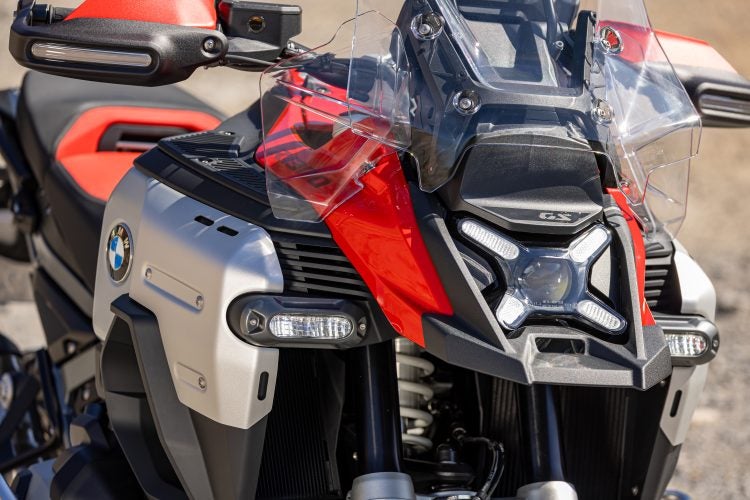
The new LED headlight can be equipped with optional adaptive lighting for better lighting in corners. LED auxiliary lights are mounted flush to the front of the tank. Photo: BMW Motorrad
You can also get the newest GS with the optional Adaptive Headlight Pro. The upgraded lighting ensures the beam of the LED headlight automatically turns into the corner according to the bike’s lean angle. As a result, the corner is better illuminated because the beam moves where the motorcycle is heading.
Power sources
To power your electronics, the bike features a 12-volt onboard power socket on the right-hand side of the cockpit. In addition, there is a USB-C socket with a 5-volt power supply in the hinged smartphone-carrying compartment on the top of the tank. A 2.4 amp charging current is available, enabling fast charging depending on your smartphone type.
6.5-inch Full Color TFT Screen
The GS’s 6.5-inch full-color display gives the rider access to vehicle and connectivity functions. An additional Sport screen provides performance information like lean angle, traction, and braking behavior, as well as a sport rev counter and gear indicator.
The screen also offers Bluetooth connectivity so a rider can make phone calls or listen to music when the rider’s smartphone is connected. In addition, when using the BMW Motorrad Connected App, riders can receive navigation assistance directly on the screen.
Standard SOS function
The bike features an eCall system, which BMW calls “Intelligent Emergency Call.” Its purpose is to get help to the scene of an accident as quickly as possible. The system can be activated automatically or manually by pressing the SOS button on the right handlebar.
3 Variants
In addition to the basic model, the 2025 BMW R 1300 GS Adventure is available in three additional variants:
- Triple Black – Model with a black paint scheme
- GS Trophy – Model more focused on off-road capability and sporty color scheme.
- Option 719 Karakorum- Aurelius Green Metallic paint. More elegant look.
- Images: BMW Motorrad
Summary:
The 2025 BMW R 1300 GS Adventure is a significant departure from its former models. According to BMW, the new GS is designed for longer journeys. The bike’s electronic systems provide much assistance to riders who desire a motorcycle capable of world travel while offering the latest electronic safety, rider enhancements, and convenience.
Pricing and Availability
The 2025 BMW R 1300 GS Adventure will be available in Q4 2024. Pricing will be revealed closer to the motorcycle’s launch date.
Technical Data
| R 1300 GS Adventure | |||
| Engine | |||
| Capacity | cc | 1,300 | |
| Bore/stroke | mm | 106.5 x 73 | |
| Output | hp | 145 @ 7,750 rpm | |
| Torque | ft-lbs. | 110 @ 6,500 rpm | |
| Type | Air/liquid-cooled 2-cylinder 4-stroke boxer engine with two overhead, chain-driven camshafts, a counterbalance shaft, and variable intake camshaft control system BMW ShiftCam | ||
| Compression | 13.3/1 | ||
| Fuel | Premium unleaded 95 RON | ||
| Valves per cylinder | 4 | ||
| Ø intake/outlet | mm | 44 / 35.6 | |
| Ø throttle valve | mm | 52 | |
| Engine control | BMS-O | ||
| Emission control | Closed-loop three-way catalytic converter, exhaust standard EU-5 | ||
| Electrical system | |||
| Generator | W | 650 | |
| Battery | V/Ah | 12/14 | |
| Headlight | LED | ||
| Rear light | Function-integrated LED brake/rear lights | ||
| Starter | W | 900 | |
| Power transmission | |||
| Clutch | Wet clutch with anti-hopping function, hydraulically activated | ||
| Gearbox | Claw-shift 6-speed transmission | ||
| Primary ratio | 1.479 | ||
| Transmission ratios | I | 2.438 | |
| II | 1.714 | ||
| III | 1.296 | ||
| IV | 1.059 | ||
| V | 0.906 | ||
| VI | 0.794 | ||
| Secondary drive | Propeller shaft | ||
| Primary ratio | 1.184 | ||
| Secondary ratio | 2.909 | ||
| Chassis | |||
| Frame construction type | Two-part frame concept consisting of main frame and rear frame bolted to it, engine co-supporting | ||
| Front wheel guide | EVO Telelever DSA central strut |
||
| Rear wheel suspension | Cast aluminum single-sided swingarm with BMW Motorrad EVO Paralever, DSA |
||
| Spring travel, front/rear | inches | 8.3 / 8.7 | |
| Wheel castor | inches | 4.7 | |
| Wheelbase | inches | 60.4 | |
| Steering head angle | degrees | 63.8 | |
| Brakes | front | Twin disc brake, semi-floating brake discs, Ø 310 mm, 4-piston radial calipers | |
| rear | Single disc brake, Ø 285 mm, 2-piston floating caliper | ||
| ABS | BMW Motorrad ABS Pro (lean angle optimized) as standard | ||
| Wheels | Cross-spoke wheels | ||
| front | inches | 3.00 x 19” | |
| rear | 4.50 x 17” | ||
| Tires | front | 120/70 R 19 | |
| rear | 170/60 R 17 | ||
| Dimensions and weights | |||
| Total length | inches | 89.8 | |
| Total width incl. hand protect. | inches | 39.8 | |
| Seat height (max range) | inches | 34.3 / 35.0 (31.0 – 36.0) | |
| DIN unladen weight, road ready | lbs. | 593 | |
| Permitted total weight | lbs. | 1,069 | |
| Fuel tank capacity | gallons | 7.9 | |
| Performance figures | |||
| Acceleration 0-100 km/h | seconds | 3.4 | |
| Top speed | mph | >124 | |
Standard Equipment:
- 1,300 cc air/liquid boxer twin motor with ShiftCam technology.
- 6-speed helical-toothed gearbox with anti-hopping clutch and shaft drive.
- Steering stabilizer.
- BMW Motorrad EVO Telelever front suspension.
- BMW Motorrad Paralever rear suspension.
- Twin disk front brakes with radial front calipers.
- Cross-spoke wheels.
- Aluminum 7.9-gallon fuel tanks with attachment points.
- BMW Full Integral ABS Pro.
- Dynamic Brake Control.
- DCC Dynamic Cruise Control with brake function (maintains speed on inclines).
- MSR Dynamic Engine Brake Control.
- DTC Dynamic Traction Control.
- Hill Start Assist.
- TPM Tire Pressure Monitor.
- Keyless Ride.
- Riding Modes.
- Heated grips.
- Full LED lighting with Matrix headlight.
- Hand protection with LED Comfort turn signals.
- Adjustable clutch and hand brake levers.
- Electronic immobilizer.
- 6.5-inch TFT display with Connectivity and on-board computer.
- Storage compartment with charging function.
- Multi-function controller.
- 12v power socket.
- Separate rider and passenger seats.
- Luggage Rack.
- Adjustable windscreen.
- Engine protection guard.
- Center Stand.
- M Lightweight battery.
- Intelligent Emergency Call.
- Ultimate Care Break-In Service.
Available Optional Equipment
Premium Package
- Riding Modes Pro.
- Sport Brakes.
- Riding Assistant.
- Shift Assistant Pro or Automated Shift Assistant.
- Headlight Pro.
- GPS prep.
- Chrome plated headers.
- Electrically adjustable windshield.
- Aluminum side case mounts.
- Aluminum top case mount.
Enduro Package Pro
- Handlebar risers.
- Short enduro hand levers.
- Height-adjustable GS Vario rider footrests.
- Hand protectors.
- Front turn signal relocation stalks.
Individual Options
- Passenger Package: Luggage rack, Comfort passenger seat, Style GS Trophy only.
- Enduro forged wheels.
- Double exhaust silencer.
- Adaptive Vehicle Height Control.
- Adaptive Vehicle Height Control Comfort.
- ASA Automated Shift Assistant.
- Comfort handlebars
- High windshield.
- Riding Assistant.
- Anti-theft alarm (dealer-installed accessory).
- Off-road tires.
- Cross-spoke wheels (black).
- Cross-spoke wheels II (gold).
- Comfort rider’s seat.
- Comfort rider’s seat, low.
- Comfort rider’s seat, high.
- Comfort passenger seat.


